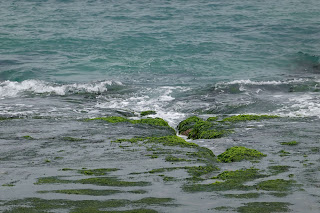After finishing lunch, we went to Fugui Cape Park in Shimen District. Fugui Cape is located at the northernmost cape of Taiwan. In the park, you can see the unique coastal landscapes such as windkanter, stone trough (tidal creek and sea groove), and sand dune. You can also walk along the trail to Fugui Cape Lighthouse, Fuji Harbor Tourism Fish Market and Laomei Community. Among them, the Laomei Green Stone Trough is a rare and special landscape in Taiwan. It was once selected by CNN as one of the eight secret places in Taiwan. It attracts many photography enthusiasts and tourists to come here. These neatly arranged stone troughs were originally left over from the volcanic reefs on the shore due to the eruption of Datun volcano. After long-term erosion by the waves, hard longitudinal grooves were left behind. Later when the northeast monsoon prevails in winter, the waves moisten the rock surface of the stone troughs and green seaweed begins to grow. When the northeast monsoon subsides in April, the stone troughs will be covered with a large area of green seaweed, forming amazing green stone troughs. Then the seaweed disappears under the exposure of summer sun. Therefore, the best viewing period is every spring after low tide from March to early May. The beautiful Green Stone Trough season is short. It is recommended to check the tide table in Shimen District of the Central Meteorological Bureau in advance. Two hours after the low tide is the best time to watch the Laomei Green Stone Trough and the area of the greenstone trough is also the widest. Since the green stone trough is not easy to grow after being trampled, it will seriously affect its ecology. And, the green stone trough is quite slippery and It is easy to fall. So for your safety concerns, do not step on it. Now there is also a fine of 30,000 to 100,000 Taiwan dollars so please pay special attention.
吃完午飯後我們接著去石門區的富貴角公園,富貴角是位於台灣最北端的突出海岬,在公園裏可看到風稜石、石槽(潮溝與海蝕溝)與沙丘等海岸景觀,沿著步道也可走到富貴角燈塔、富基漁港及老梅社區。其中老梅綠石槽是全臺少見的特殊景觀,曾被CNN選為台灣8大秘境之一,會吸引許多攝影愛好者及遊客慕名而來。這些排列整齊的石槽,早先是因大屯火山爆發遺留岸邊的火山礁岩,經過長時間海浪侵蝕,而留下堅硬的縱狀溝槽,之後在冬季東北季風盛行時,浪花滋潤了石槽的岩面,便開始生出綠色的海藻,等到四月份東北季風漸歇,石槽就長滿了一大片綠色的海藻,形成令人驚嘆不已的綠石槽,隨後海藻就在夏日陽光的曝曬下而消失,所以在每年春季3~5月上旬退潮後為最佳觀賞期,美麗的綠石槽季節短暫,建議可以事先查看中央氣象局石門區的潮汐表,乾潮後2小時為觀賞老梅綠石槽的最佳時間,這時綠石槽的面積範圍也最廣。由於綠石槽被踐踏過後就不易生長,會嚴重影響到綠石槽的生態,而且綠石槽相當滑溜、易跌倒,為了安全起見切勿踩踏上去。現亦有制定3萬元以上10萬元以下罰鍰,請大家要特別留意。
圖片庫 - 點擊放大
The cause of Fugui Cape Windkanter is formed of pieces of stone ejected in the Datun Mountains volcanic group. Long-term erosion by sand bearing northeast monsoon winds has left the stones with smooth, flat surfaces and when the wind changes it forms sharp angles on the stone. This is called “windkanter”.
富貴角風稜石的成因是大屯火山群噴發崩落下來的安山岩塊,長時間被東北季風吹襲,岩石被由風力捲起的細沙不斷的風襲磨蝕,日積月累之下漸漸的將原本有稜有角、形狀不規則的岩塊,磨蝕成平坦的蝕面,若風向改變,則形成尖銳的稜角,稱為風稜石。
Fugui Cape Lighthouse, formerly known as Fuji Cape Lighthouse, is the northernmost lighthouse in Taiwan. Construction started 16 years before the Republic of China (1896) during the Japanese colonial period. It was the first lighthouse built by the Japanese in Taiwan. The reason for its construction was to connect submarine cables and navigation equipment between Taiwan and Japan. The building materials were shipped to Taiwan by Japanese ships, and the lighthouse body was manufactured in Japan and then shipped to Taiwan for assembly. It was completed in 1897. The octagonal lighthouse was originally made of iron, but it was changed to concrete in 1962. Due to the special geographical environment and climate, dense fog often occurs in autumn and winter, so a foghorn (fog signal) is attached to the tower. This is the first time a navigation mark has appeared in Taiwan. The black and white octagonal lighthouse is quite eye-catching. In addition, it is also a famous landmark for shooting "Beautiful Hanging Sun''. At sunset, the fiery red sun just falling in the middle of the lighthouse and the orange light illuminating the sky form a rare spectacle.
富貴角燈塔原名富基角燈塔為台灣最北端的燈塔,於日治時期民國前16年(1896年)動工興建,是日本人在臺灣興建的第一座燈塔,興建的原因是當時為了連接台灣與日本之間的海底電纜及航路設備。建材均由日本船運來台,塔身在日本製作後再運抵台灣組裝,於1897年建造完竣。塔身原為八角形鐵造,民國51年(1962年)改為八角形混凝土,由於特殊的地理環境及氣候,秋冬季節常出現濃霧,因此在塔內附設「霧笛」,這是首次在臺灣出現的航路標誌。富貴角燈塔黑白相間的八角形外型相當搶眼,除此之外它也是拍攝「懸日美景」的著名地標,當太陽緩緩落下,火紅懸日正好落在燈塔中間,橘黃色光線照亮天際,形成難得一見的「燈塔懸日」奇景。
Fuji Fishing Port is a tourism fishmarket close to Greater Taipei. It is mainly engaged in inshore fishery. It is famous for catching crabs, and there are also many other fish, shrimps, mussels, lobsters, and squids. In early 1995, the Jinshan Fishermen’s Association established the Fuji Fishery Direct Sales Center in Fuji Fishing Port. Fishing boats returned to port at about 5:00 p.m. every day, and the seafood they caught was sold directly. Therefore, you can buy delicious, cheap and fresh seafood here. Although there are no seafood restaurants near the port, fishmongers have cooking services for a small fee so you can enjoy all kinds of delicious seafood meals immediately.
富基漁港是鄰近大臺北的一座觀光漁港,以從事近海漁業為主,它以捕花蟹聞名,其他的魚蝦、蚌、龍蝦、烏賊也不少。於民國84年初,金山區漁會在富基漁港創設富基魚貨直銷中心,漁船每天大概在下午5點返港,捕獲的海鮮直接銷售,所以在此可以選購物美價廉、新鮮肥美的海鮮。雖然港旁沒有海鮮餐館,但是魚販區都有代客料理的店家提供烹煮的服務,只須少許代工費,即可馬上享用各式美味海鮮大餐。
相關文章



























